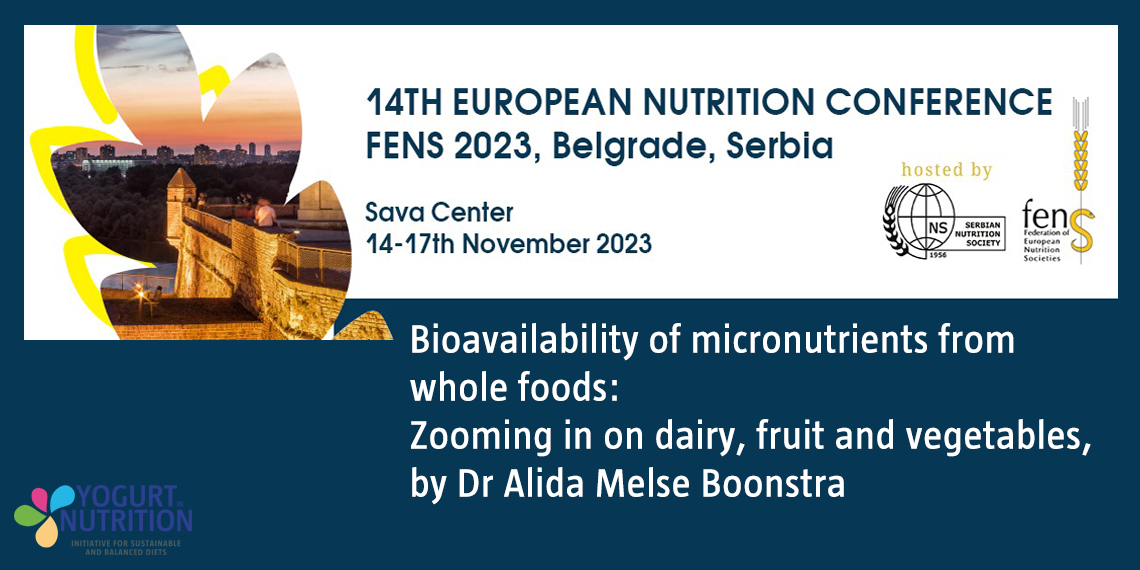Dr. Alida Melse-Boonstra from Wageningen University in the Netherlands delved into the crucial topic of “Bioavailability of Micronutrients from Whole Foods: Zooming In on Dairy, Fruit, and Vegetables.”
Bioavailability of Micronutrients from Whole Foods, briefly
Bioavailability is defined as the fraction of nutrient absorbed from the diet and used for physiological function or storage (retained in body). Bioavailability is an important intermediate between dietary intake and requirements, involving both food-related factors (such as the amount of nutrient, food matrix or food processing…) and host-related factors (gut health, body composition, infectious diseases, genetics…)
How to assess bioavailability?
Various methods exist to assess micronutrient bioavailability:
- In vitro techniques, designed to simulate the in vivo environment, are based on a simulated digestion process and assess element availability. While fast, inexpensive, and highly controllable, they have limitations as they only provide a proxy for in vivo bioavailability.
- In vivo techniques (conducted in animals or humans) use various methods (chemical balance, isotopic…) and are quantitative but more complex, expensive, and less controllable.
Milk, dairy, fruits and vegetables
Delving deeper, the focus shifted to the micronutrient bioavailability from milk and dairy, compared to that from vegetables and fruits.
Both milk and dairy as well as vegetables and fruits are nutrient-dense foods that provide nutrients which impact human metabolism and health. They contain a myriad of nutrients, for some of which the bioavailability is now well-understood, whereas others still require further study. They also contain many bioactive components and have a complex matrix, which affect the kinetics of nutrient release, absorption, and bioavailability.
For example, we observe that milk for instance enhances the absorption of zinc from rice, which contains phytate, an anti-nutrient that may inhibit the absorption of zinc or iron. In the same way, guava fruit enhances the absorption of iron, but not of zinc, from a rice-based meal.
Key Messages:
- Bioavailability is a vital intermediate between dietary intake and nutritional requirements.
- Milk and dairy products generally contain many enhancers and few inhibitors of nutrient absorption and bioavailability.
- Vegetables and fruits, with food matrix complex structures, may impede nutrient absorption.
- Nutrient bioavailability is not a fixed number but a result of the complex interplay between food-related and host-related factors.
Dr. Alida Melse-Boonstra’s insights underscore the intricate dynamics that shape the bioavailability of micronutrients from whole foods.
Source: Melse-Boonstra A. Bioavailability of Micronutrients From Nutrient-Dense Whole Foods: Zooming in on Dairy, Vegetables, and Fruits. Front Nutr. 2020 Jul 24;7:101. doi: 10.3389/fnut.2020.00101. PMID: 32793622; PMCID: PMC7393990.
Learn more with Alida Melse-Boonstra
Hello, can you introduce yourself?
A. Melse-Boonstra: I’m Alida Melse-Boonstra, an associate professor at the Division of Human Nutrition and Health at Wageningen University in The Netherlands.
Can you tell us what would qualify the challenge of studying bioavailability?
A. Melse-Boonstra: Studying bioavailability poses significant challenges, requiring meticulous planning and study design. The complexity, technical demands, and associated costs make these studies inaccessible to everyone. Fortunately, organizations like the International Atomic Energy Agency offer crucial support, both technically and financially, making these studies feasible. Nevertheless, conducting in vivo studies on bioavailability remains inherently challenging.
You presented some data about bioavailability in dairy. How does the bioavailability of different micronutrients vary among dairy products, and which factors contribute to these differences?
A. Melse-Boonstra: Each micronutrient possesses unique and intricate properties, influenced by its chemical characteristics. Divalent metals, for example, exhibit a consistent pattern in their behavior concerning enhancers and inhibitors. However, other nutrients showcase distinct chemical properties.
Variations exist within different dairy products. Factors such as acidic conditions prove advantageous for divalent metals, while fermentation products can stimulate the absorption of certain vitamins, like vitamin K. The matrix of a food, including these differences, plays a defining role in how a specific nutrient is absorbed.
Dr. Alida Melse-Boonstra is currently an Associate Professor at the Division of Human Nutrition, Wageningen University & Research. She focuses her research on new and sustainable solutions for micronutrient malnutrition in low- and middle-income countries. She studies vitamin A, iron, iodine and zinc deficiencies in relation to growth and health in vulnerable population groups such as pregnant women, infants, children and adolescents. She applies various stable isotope dilution technique to assess nutrient status and absorption. Major highlight of her research during the past few years is the research on biofortified cassava in Kenya and in Nigeria



